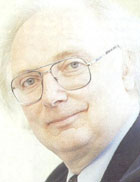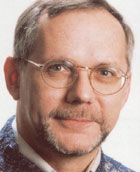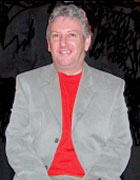2007 Butlins Mineworkers Championships - The test pieces
16-Jan-2007There are five test pieces on show this weekend. This is what the composers tell us about their works.
 Northern Lights Philip Wilby
Northern Lights Philip Wilby
For the band's 150th anniversary, The Black Dyke Band initiated a number of special projects which are designed to expand the brass band's traditional boundaries.
'Northern Lights' is another such composition, which consisted of a set of Dance Variations in which musicians and dancers interacted freely, and during which soloists emerge from the band. There are self conscious nods in the direction of the brass bands famous history, and much of the musical fabric is drawn from the famous bandsman's hymn Deep Harmony, which finally appears in the climax of the piece.
The present score for brass band alone, contains one or two small changes from the original dance version, including a small cut in the rapid music before the cadenza. However, it uses the same musical content, and seeks to provide every player in the group with a solo part.
Each variation is cast in a different musical colour, freely using harmonies and muted sounds in combination to create a sequence of separate dramatic pictures, some pastoral, and others more dynamic. The Northern Lights project was originally developed by interaction of musicians and dancers, (initially as part of a 2004 Sefton Music Support Service music and dance project) and my score uses these different sounds and musical gestures simply because of that meeting of creative energies.
Philip Wilby
 Music for the Common Man Kenneth Downie
Music for the Common Man Kenneth Downie
The Theme, stated at the outset, is largely reflective in mood (written in memory of Theodore Cooney), albeit with underlying moments of tension. Fragments of it re-emerge between the fast section which all derive from the opening material. The theme returns triumphantly near the end, and after a series of changing moods, serenity and repose are re-established.
The title has a three way aptness. It indicates the unpretentious nature of music, it alludes to a universally known fanfare and symphony, and it make a fitting tribute to my uncle who died while I was writing the music, and who did much to encourage me as a composer.
Kenneth Downie
 Kaleidoscope (Five Variations on the Brugg Song) - Philip Sparke
Kaleidoscope (Five Variations on the Brugg Song) - Philip Sparke
Kaleidoscope was commissioned by the Aargau and Waadtland Music Associations (Switzerland) with financial help from the town of Brugg and City Pharmacy, Brugg (Dr. M & B Kuhn) as the test piece for the Aargau and Waadtland Cantonal Music Festivals held in May and June 2003. It was composed simultaneously for concert band, brass band and fanfare band for use in all three divisions.
It is a set of five variations on Das Brugger Lied' (The Brugg Song) which is the traditional song of the town of Brugg. The lyrics tell of the geography, people and traditions of this charming and historic town, which is situated in the north of Switzerland, near to the German border, about halfway between Basle and Zurich.
The variations are based on tiny extracts of the Brugg theme, the whole piece therefore resembling the effect of a kaleidoscope, which juxtaposes small fragments of colour in a constantly changing pattern.
The introduction is inspired by the many rising intervals which start phrases within the song, and the main theme is then introduced.
Variation 1 is based on the dotted rhythm which permeates the song, particularly from the first bar. The short interlude which is Variation 2 plays on the interval of a seventh midway through the song. Variation 3 uses a waltz-like theme derived from a later extract with a central theme derived from a rising third figure. Variation 4, a slow ballad, is once again based on the opening bar.
The finale, Variation 5, starts with a moto perpetuo derived from a later extract of the tune. In bar 275, a contrasting theme based o a latter extract briefly interrupts, but the moto perpetuo returns, eventually acting a descant to the reintroduction of the Brugg Song its entirety. A shot coda recalls material from Variation1 before bringing the piece to a crashing close.
Philip Sparke
 Edwin of Northumbria Keith Wardle
Edwin of Northumbria Keith Wardle
Composer's notes from website.
I've had several enquiries asking if a commercial recording is available - sorry no - the music is brand new - but I'd love to think a good band would record it one day.
This means Butlins section 3 could have all the thrills and spills of contesting as it was before things such as "Area CD's" - all the bands and conductors bringing an approach they think best determined only by the score markings and their own abilities - This adds another dimension to competition that I for one have missed.
First movement:
The overall canvas I'm trying to portray is of a very orderly, early seventh century Northumbria with a well respected king in tight control of a developing society.
The opening theme is the oldest melody I could find that gave me the opportunity to develop the harmony and counterpoint from which the rest of the work often spawns. It has no composer attributed to it. Hopefully, by the end of the work it is apparent to the listener that this is indeed, Edwin's theme. It's been used elsewhere now and then, most recently as far as I can tell, by Vaughan-Williams about seventy years ago - but I've traced it back over six hundred years.
I've fragmented Edwin's theme from the start, allowing for a figure to interject it that is intended to show a distant challenge distant not just in terms of space but also of time some twenty five years into Edwin's future.
As the harmony fills out, if a part spawns off from a note already being played, it is marked to start from nothing I'm trying to interest the listener by making the music less obvious.
Into the marzial, the main part of movement 1. These bars lay down how the music will be framed and hopefully, the listener is drawn away from the opening into believing s/he is hearing the main theme in fact this is the secondary theme and fits together with Edwin's theme later.
Often, the players at the bottom of a section are given some quite difficult melodic passages, but I decided to include them when the part is soli on several parts, rather than permanently demote them to the often easier accompaniment parts.
Tempo ritmico is a marking I use often, I get very concerned about conductors messing about with composers' metronome markings and hopefully, this marking gives out the message that I for one, do actually know the tempi I wish the music to be played at.
By letter G, towards the end of the first movement, the primary and secondary theme is busily accompanied and the movement ends in a definite fashion having never reached ff from start to finish.
2nd Movement:
I am trying to portray "hope" - and the realisation by Edwin that there is more to the development of his kingdom than killing everyone who doesn't subscribe to his sovereignty.
The Flugel/glock ostinato is designed to tease the ear. The harmony and melodic passage superimposing it from the middle of the band, changes mode each bar from major through diminished and then back through minor to major, but defiantly the ostinato fits without anything but a slight, hopefully tasty, dissonance.
The main theme of this movement is stated from the ninth bar on EEb bass and trombone and my favourite incarnation of it comes next at letter "I" when the solo horn plays the secondary theme against the primary.
For many years Gilbert Vinter has fascinated me, and I wouldn't claim this writing to be in his class I fear I'll never reach such ability but these bars are intentionally reminiscent of his incredible ability to provide sweet and sour sentimentality - hopefully, to the emotional delight of the listener.
"J" Maestoso - builds to the climax of the movement when the two stated themes and the opening ostinato, on trombones and bells are all played together at "K" When testing the piece at my band - I could the feel the players doubting not only their own ability to read key signatures, but my ability to write cohesively after a few looks - in other words once the players played the right notes at the right time, letter "K" worked fine.
After the ff section, the music is more teasing and settles into "M" when I attempt to show Edwin starting to understand his life and his potential. "M" to "N" is intended to be very intimate. This leads to a point of understanding and the close should be serene, played simply without fuss or ornament.
3rd Movement
Intentionally opposite to the close of the 2nd, the listener is invited to be worried and put on edge. Seventh century warfare, I imagine, would have had the same result as twenty first century warfare only more "plodding" - It would be easier then to limp away and only be wounded but what would then happen to the wounded?
The opening bars set the scene and at bar 3 of "O" the main theme of the movement is played by the basses this is my idea of the conflict of the time. The tempo is again marked Tempo ritmico. 104 crotchets/minute is the way I intend the listener to hear this.
From "P" the percussion is one of my main ways of portraying the story especially the duet between players one and two at bar 179 and 198.
In bar 4 of "S" Edwin's theme is heard again and I have juxtaposed this starting on a weak part of the bar in 4/4 the anacrusis is on the third beat, but I've drawn a vertical line on the score to bring attention to the conductor and I go for two separate simultaneous performances by reinforcing Edwin's theme using percussion so even though this introduction is rude, unwanted, not fitting the flow, it has to be considered by the listener. This is constructed to show the two apposing sides in the conflict - Edwin and his Northumbrians against Penda and his Mercians.
This is Edwin's final sortie and the way I see it Edwin knows it too.
"T" is the actual fight between Edwin and Penda - maybe it didn't happen head to head - one to one - but it does here! I considered increasing the tempo here but decided it should stay the same. After all, we are still talking "plodding warfare" with armour heavier than its occupant. "U" is the moment of death and again when test playing it at my band, in the small break at the end of bar 222 someone from the Euph/Bari row, quietly but audibly went Uugghhh..hhh.h.h . I loved it! It meant I had portrayed what happened (Appropriately at "U" for Ugghhhh,...) either that or someone had a very dodgy tea before rehearsal.
As the music calms to a sad moment (mesto) the bells are reintroduced and a note cluster builds to a final Maestoso. The final bars from "V" see Edwin elevated in status from mortality to immortality. Society and Christianity, by eventually overcoming heathenism in the years following Edwin, proved that you can defeat a king - but you can't defeat a saint.
- Thanks for reading I'm sure these notes will be of no benefit at all!
Judges, conductors, players, audiences, organisers and pundits - will we ever all agree? ...Naahhh
(But let's keep doing it great fun!)
The Journeymen Ray Steadman-Allen
The Journeymen is an attractive, tuneful suite of four movements whose styles and moods are suggested by their subtitles.
Wayfarer is rhythmic and perky. Pilgrim is in a more meditative vein with a flowing melody: a central section is cast to resemble a medieval dance. Sundowner may be best described as a soft shoe shuffle' with a lazy tune, whilst Commuter is a strong, bustling finale.
Ray Steadman-Allen















